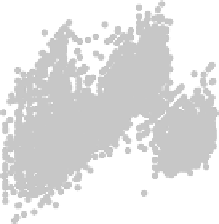Geoscience Reference
In-Depth Information
A
Individual level (A)
B
Species average (D)
Broadstone Stream (Br)
Celtic Sea (Ce)
Afon Hirnant (Af)
Tadnoll Brook (Ta)
Guampoe River (Gu)
Trancura River (Tr)
Coilaco River (Co)
6
6
Ta
4
4
Ta
Gu
Co
Br
Tr
Co
2
2
Tr
Af
Ce
Af
Ce
0
Gu
0
Br
−2
−2
−4
−2
0
2
4
6
−4
−2
0
2
4
6
log
10
(predator mass)
Species average log
10
(predator mass)
C
Link average (C)
D
Size class binned (F)
6
6
Ta
Ta
4
4
Br
Co
Tr
Tr
2
2
Br
Af
Ce
Af
Co
Ce
0
0
Gu
Gu
−2
−2
−4
−2
0
2
4
6
−4
−2
0
2
4
6
Link average log
10
(predator mass)
log
10
(predator size class mass)
Figure 6
PPMR versus predator mass, all systems together. (A-D) show feeding
events for the raw data (resolution A), species averages (resolution D), link averages
(grouping C) and size classes (grouping F), respectively. The trend lines show the
LMM PPMR-predator mass response variable per study system (identified by colour/
abbreviation of study system). The dashed line indicates where prey size equals
predator size.
aggregation (F) had greater slopes (mean of 0.433) than did the link average
(C) taxonomic grouping (mean slope of 0.283, t
¼
2.594, df
¼
6, p
¼
0.041,
Figure 4
E).
e. Species Mass-Trophic Height (Grouping). Slopes for each study system
under both aggregations were estimated using OLS regression (
Figure 7
).
The results from the paired t-test (
Figure 4
A) revealed that the slope of this
relationship was steeper when individuals were aggregated into food webs


























































































